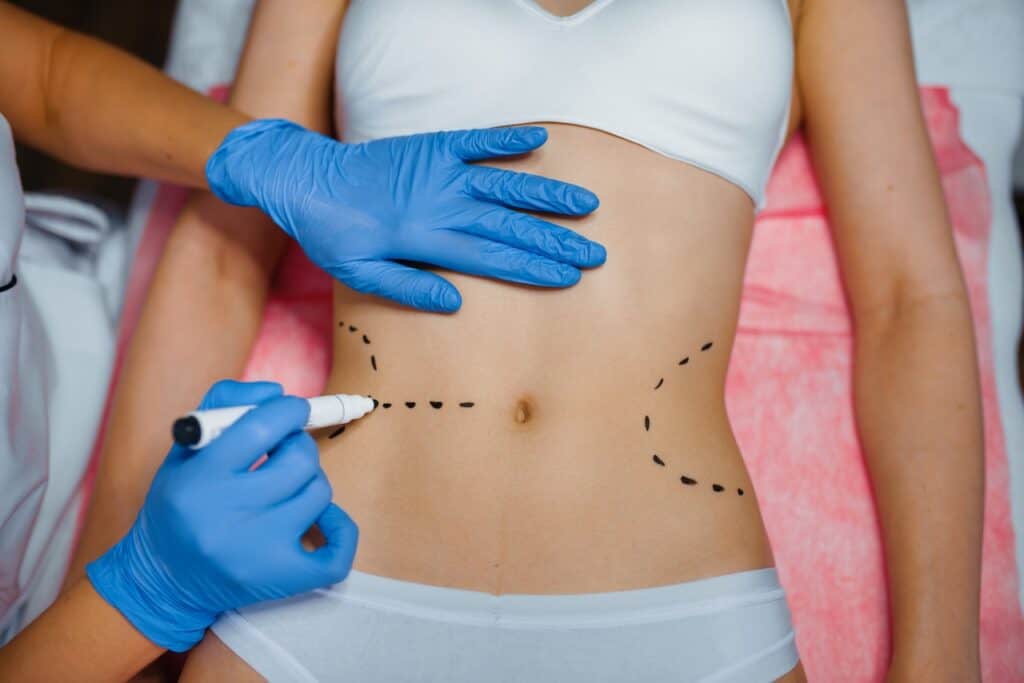Let’s dive into some of the most important topics about liposuction and how we can help.
Liposuction Candidacy
- Health Requirements: You should be in good overall health and free from serious medical conditions, such as heart or lung issues. Our surgeon will evaluate your medical history to be certain the procedure is safe for you.
- Stubborn Fat: Liposuction targets fat deposits that don’t respond to diet or exercise. Our surgeon uses advanced techniques to sculpt specific areas and enhance your natural shape.
- Realistic Expectations: You should understand that liposuction helps shape your body but it doesn’t replace a healthy lifestyle. Our liposuction center in New York will work with you to set clear goals and deliver the best possible results.

Liposuction Anesthesia Options
There are three main anesthesia options for liposuction surgery. The option used will depend on the complexity of the procedure and what is best for you.
Local
Our surgeon uses a tumescent solution to numb the treatment area. This allows you to stay awake and comfortable during the procedure. The option minimizes risks and offers a quicker recovery.
Sedation
If you are undergoing a more extensive procedure, we may recommend sedation anesthesia. Sedation offers a balance between comfort and a shorter recovery time compared to general anesthesia.
General
For complex cases, our surgeon might use general anesthesia to ensure complete comfort during the procedure. This option is less common but may be necessary based on your individual needs.
Specialty Procedures
Here at the New York Liposuction Center we cover all types of liposuction surgery. We also specialize in male liposuction procedures as well as Lipo 360. If you are looking for more general plastic surgery, we have you covered there too!
Male Lipo
Male liposuction targets areas like the abdomen, chest, and flanks to enhance muscle definition and remove stubborn fat. Our surgeon tailors the procedure to achieve a more masculine, contoured appearance.
Lipo 360
Lipo 360 offers comprehensive fat removal around the entire torso, including the abdomen, love handles, and back. This technique provides a full, all-around contouring effect for a more sculpted body.
Liposuction Surgery
- Planning Your Procedure: During your consultation, we will review your medical history and discuss your body goals. If you’re undergoing revision liposuction, we will carefully assess your previous procedure and design a customized plan to improve your results.
- Pre-Surgery Guidelines: Our surgeon will provide specific instructions, including what medications to avoid and if fasting is needed. You may also be asked to arrange transportation for the day of your procedure and have someone stay with you for 12 hours post-surgery.
- During the Procedure: Our surgeon will perform liposuction using small incisions to target and remove unwanted fat. Advanced techniques like SmartLipo will help minimize discomfort and allow a quicker recovery, so you can enjoy your results sooner.

Liposuction Recovery
- Initial Recovery: You can expect some swelling and bruising after your procedure, which typically goes way within a few weeks. Our surgeon will walk you through what to expect to ensure an easy recovery.
- Wearing Compression Garments: We recommend wearing compression garments to reduce swelling and support healing. These garments help your body adjust to its new contours and promote optimal results.
- Long-Term Care: You should plan to maintain a healthy lifestyle with proper diet and exercise to preserve your new look.

Liposuction Cost & Financing
Some of the major questions that come up regarding liposuction center around the cost for surgery and financing options.
Lipo Costs
The cost of liposuction varies depending on the number of body areas treated, with multiple areas increasing the overall price. More complex procedures, such as combining liposuction with other types of plastic surgery, will also add to the total cost.
Financing Surgery
We offer flexible financing options to help make liposuction more accessible, including CareCredit, Alphaeon, and other providers. Our team can help you with choosing the best plan to fit your budget and make your procedure as affordable as possible.
Schedule a Free Consultation
Fill out the form or at call us at (917) 809-7787 to schedule your free consultation with the New York Liposuction Center and get started on your liposuction journey.